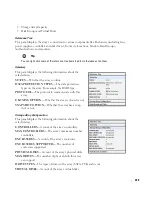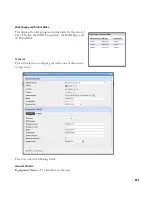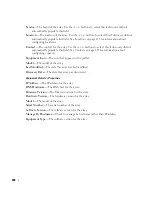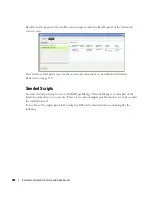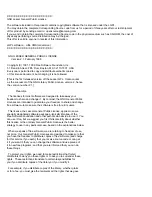
Actions Portlet | Actions and Adaptive CLI
349
General
The following are parameters to configure in this panel:
Name
—A unique identifier for this action. For example: “Retrieve MyDevice MAC addresses.”
For a new action to appear on the right-click Action menu, begin its name with the vendor
name. For example,
Force10-showversion
would appear under Actions in that menu.
Otherwise, it appears under and Adaptive CLI classification.
Description
—A text description of the action.
Type
—Select a type from the pick list (
Configure, External
or
Show Command
).
Tip
You can use Dell OpenManage Network Manager’s optional Proscan policies to scan Adaptive CLI show
commands for compliance, and trigger actions (alarms, e-mail, and so on) based on their contents. See
Chapter 9, Change Management – ProScan.
The
External
command refers to a script. Making this an ACLI means Dell OpenManage
Network Manager can schedule such scripts or include them in a workflow. See External
Commands on page 360 for more about these.
Target Type
—Select a type of target from the pick list (
Card, Equipment and Subcomponents,
Interfaces, Managed Devices, Ports
). Adaptive CLI targets can also be
None
(
Targetless)
. On
execution, if you create an Adaptive CLI type with port target, then the selection view panel
lets you choose ports. When the Adaptive CLI type is
External
then Target Type can be
None
;
otherwise it is not an option
Export File Location
—This is a file name and path (
C:\mypath\myfile
) where you elect to
store the result of an adaptive CLI execution. You may specify the variable
$IPAddress
in
the filename for pattern substitution.
Overwrite on Export
—Check to overwrite the result file. This overwrites any existing results file
with new results (if checked). If it is unchecked, the new results appends to the file.
Is Batch Execution Enabled
—Check to allow consolidation of related Adaptive CLI scripts,
provided the associated device driver supports such consolidation when provisioning a service.
Batching is valuable for instances like the following: if an Adaptive CLI-provisioned service
has 10 sub-services, OpenManage Network Manager runs commands for the first service, then
if it’s successful, commits, and logs off. Then OpenManage Network Manager repeats this
procedure nine times more, logging on, committing and logging off for each command. If
batching is turned on, then OpenManage Network Manager sends the 10 Adaptive CLIs to
the device as a single unit before committing and logging off. (This logic does not apply if you
are running a procedure against 10 devices.)
Batching is best practice, since if one line of a command fails, the device rolls back the entire
block of commands. Cisco devices typically skip and do not commit failing lines.
Содержание OpenManage Network Manager
Страница 1: ...Dell OpenManage Network Manager version 5 1 Web Client Guide ...
Страница 14: ...14 A Note About Performance Preface ...
Страница 98: ...98 Schedules Portal Conventions ...
Страница 141: ...Vendors Key Portlets 141 Vendors Snap Panel The snap panel displays the icon for the selected vendor ...
Страница 142: ...142 Vendors Key Portlets ...
Страница 232: ...232 File Management File Servers ...
Страница 242: ...242 Deploy Configuration ...
Страница 290: ...290 Key Metric Editor Monitoring Metrics This panel s display depends on the selected device ...
Страница 340: ...340 ...
Страница 374: ...374 Adaptive CLI Records Archiving Policy Actions and Adaptive CLI ...
Страница 380: ...380 Glossary ...
Страница 388: ...388 388 Index ...

